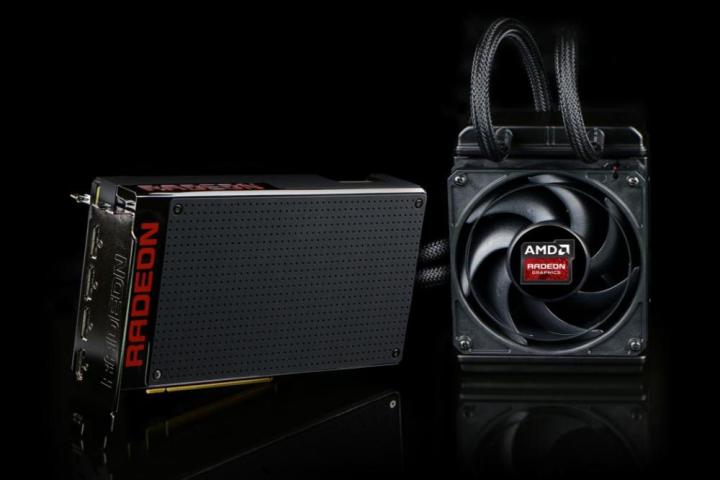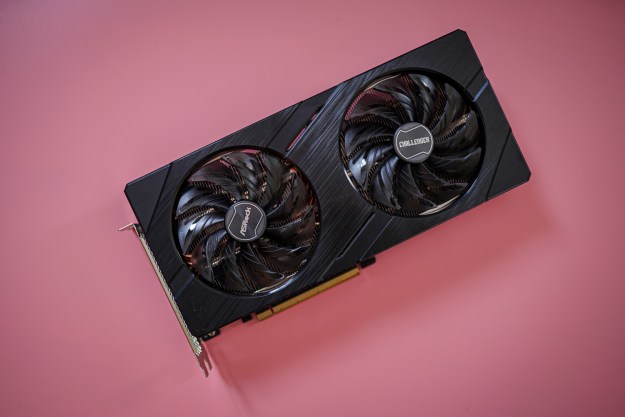
What is HBM?
A graphics card is a board with a graphical processor, or GPU, and then a chain of memory arranged in some quantity and formation around it. HBM mixes things up by stacking all of the memory right on top of the main chip, right next to the processor. This has a number of profound effects on a graphics card’s power usage, performance, and scalability.
Technically speaking, HBM works by laying an interposer over the typical base layer of package substrate. The interposer is an AMD-designed silicon chip that allows the HBM to communicate quickly with the substrate, as well as directly through the GPU without using any transistors or repeaters.
Both HBM and the interposer rely on passing signals from the top of the silicon to the bottom, a method that AMD developed that allows the memory to communicate not through one single I/O, but instead at many points along the physical chip.
Speaking with AMD representatives, you can tell that the brand has put all of its eggs in the HBM basket, and the newly announced Fury X is the perfect example of why that makes so much sense. Its gain isn’t the typical 10 or 15-percent improvement we’re used to seeing, but instead far more substantial, with AMD quoting efficiency gains of up to three and a half times over GDDR5.
The fury without the sound
The newly designed 7.5-inch PCB of the Fury X is 30 percent shorter than the R9 290X, one of AMD’s former high end cards. That’s not a small difference, and it comes with a bump in performance and power efficiency that’s unbelievable.
It’s quieter, too. Built-in liquid cooling makes setup a snap, and keeps the temperature down to levels that AMD says have never been seen before in a graphics card. The Fury X is built from the ground up for 4K and VR gaming. In the latter especially, you need to make sure that framerate is smooth, and latency is low, otherwise people will feel physically ill while playing.

Getting down to the nitty gritty, the Fury X packs in 4,096 stream processors, racking up to 8.6 teraflops. But these cards aren’t just about hitting benchmarks or filling out spec sheets, AMD has tested them in real world situations, and promises real world results.
While the Fury is impressive, the gains of HBM are perhaps most obvious in the upcoming R9 Nano, a card that’s three times smaller than current high-end video cards, yet doubles the performance-per-watt of the outgoing R9 290X. It’s hard to overstate how big of a jump that is. It’s enabled completely by HBM, which uses 94 percent less surface area per gigabyte than GDDR5.
AMD says the Fury X will hit shelves on June 24th, and will retail for $649. An air-cooled version of the card drops the X for a $549 price tag, but won’t see wide release until July 14th. The Fury Nano and Quantum Computing project are slated for a release sometime later this summer.
It’s not really quantum, but it is cool
AMD also showed off a flashy, non-traditional form factor PC at their Gaming Evolved show, which is slightly misleadingly called the “Quantum Computing Project.” The top half of the machine features dual Fiji cores. The bottom features the rest of the components of the computer, with liquid cooling running up the spine in the middle.

With quick performance and ultra-quiet operation, these PCs could make excellent home theater machines for a 4K TV, or a dedicated VR platform. Other than what’s listed above, we don’t really know anything about the computer’s’ performance or release information. It’ll be interesting to see if this machine actually makes it to market, or if AMD just intends to use it as a marketing and benchmarking platform.
A return to competition?
It’s clear from the press conference that AMD is tired of being seen as “the other option.” The brand wants to be known as the innovator, the first to move, and that’s why HBM and the quantum computer project are critical to the brand’s success. The Fury hits the market on the 24th of this year, so we’ll know then if the company has met its goal.
The implementation of HBM at AMD will spread not only to the rest of their product line over time, but also to other manufacturers, and that’s okay, because until now other brands have said it was impossible to pull off. As Joe Macri, Product CTO for AMD, puts it, “People say there’s a wall, but we’re engineers, we build the wall, we can build a new wall, or climb over this one.”
Editors' Recommendations
- AMD’s graphics card sales just took a nosedive
- GPU prices are back on the rise again
- How 8GB VRAM GPUs could be made viable again
- AMD’s GPUs had a bigger year in 2023 than you might realize
- The most common GPU problems and how to fix them




